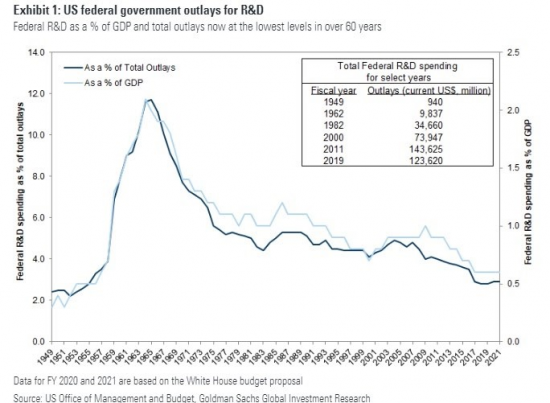In the previous entry in this series, we discussed the long-term decline in US public sector R&D investments and how that trend does not bode well for the continued US pre-eminence as a world power in the decades and centuries to come. It’s worth spending some more time on this since it is now in vogue to say things like “small government is always better than big government, ” “everything good happens in the private sector, “the private sector is where most of the great scientific breakthroughs happen, ” “raising taxes of any kind to increase government revenue is communism!!” There may be some truth in any of these statements but reality is far from that simple. And, if this type of thinking becomes too pervasive and people choose leaders who subscribe to this way of thinking, it will be unlikely to reverse these trends.
A recent Goldman Sachs report on US Science investment pains a gloomy picture of these trends. GS report notes, “The United States successfully first landed astronauts on the moon in 1969. With less urgency in the space race, federal R&D spending gradually decreased over the next two decades to about 4.6% of the federal budget, and stayed at around this level until the 2008 Global Financial Crisis and Great Recession.” And here’s where we are today: “In FY 2019, federal R&D spending equaled 0.6% of US GDP and 2.8% of total federal outlays, the lowest in over 60 years.”
It’s important to note that the absolute dollars invested are higher than before. However, with a much larger economy today, more innovations are needed to move the needle on economic growth and job creation. As such, the R&D expenditures as a percentage of the GDP (or federal budget) are the better indexes to pay attention to (Exhibit 1.)

The graph in the previous blog post in this series showed that the private sector investment in R&D has increased at the same time that the public sector R&D has shown a steep decline. Although this is great, most of that research is goal-oriented and focused on specific products that support a business model, rather than creating entirely new industries and platforms.
Goldman report writes that “The majority of federal R&D funding is used to conduct research, including basic research that focuses on the advancement of knowledge, and applied research that focuses on solving specific practical problems. In contrast, R&D spending in the private sector tends to focus on the development of specific products and processes.”
Countries that develop the industries and platform technologies of the future will get to write the rules for those industries. If you are writing the rules, you make them more favorable to your system and economy. That means they will enjoy a competitive advantage, as we have over the last century or more. China has been putting significant dollars into building their R&D infrastructure and trying to become the leader in high-tech industries like artificial intelligence. That has resulted in them closing the gap with us in key areas and now challenging us in some of those industries.
So, why would a wise industrial policy that would take us back to our own glorious recent past when we invested heavily in basic R&D make us a communist country??






